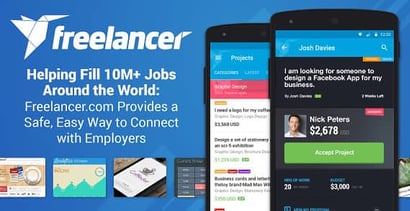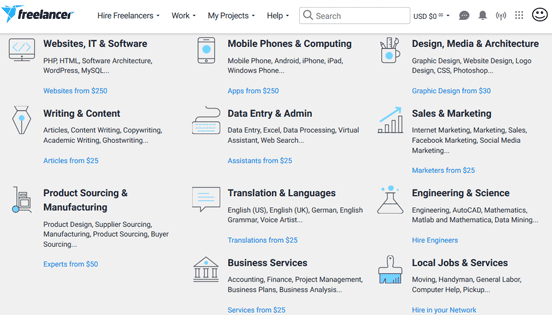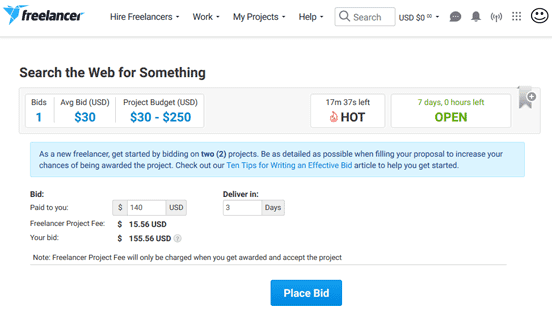

In a Nutshell: Finding yourself suddenly — or even not-so-suddenly — unemployed can be a huge blow to both your self-esteem and your bottom line. Whether you need to make a living or just make ends meet, you can use Freelancer.com to help find work. Connecting more than 20 million freelancers and employers around the world, Freelancer.com is an easy, safe way to find, bid on, and get paid for freelance work. With over 900 categories, including website development, design, administration, and work in local services, like construction or cleaning, Freelancer.com is bound to have the right projects for just about any freelancer in need.
In my grade-school history classes, we learned all about the Great Depression of the 1930s, a time in which the entire world was in financial distress. In the U.S., thousands of banks failed and unemployment rates peaked with a full quarter of the workforce without jobs.
Since that time, the Great Depression has been the standard by which all other economic problems are compared. The lessons learned from that difficult period also helped prevent the global financial crisis of the late 2000s from becoming — well, another Great Depression.
Of course, the Great Recession, as it’s now known, still had lasting domestic and worldwide impacts, which included heavy financial losses across many sectors of the U.S. economy. As the housing market faltered and the banks struggled, the rest of corporate America wasn’t far behind; and, as companies floundered, jobs disappeared.
“I was living in Arizona when the economy tanked. The house I lived in went into foreclosure and the city turned off my water because I couldn’t pay the bill,” described Adrian Sferle, who was one of the thousands unemployed during the recession.
He’s now the Marketing and Communications Manager for Freelancer.com North America, one of the leading sites connecting freelancers with employers. And, if anyone can effectively market Freelancer.com, it’s probably Adrian. Before he joined the company, he used the site to help him make ends meet during his unemployment.
“People were laid off left and right — I couldn’t find a job. So, I turned to what I thought could help — my design, illustration, and writing talents.” Adrian went online and began freelancing, earning enough to pay his bills while he looked for a new job. “Those were tough times and sites like Freelancer.com helped me get through the recession.”
Even now, with the economy slowly coming around, millions of people are using Freelancer.com to make ends meet, make a little extra — or even make a living.
Find the Right Jobs with Over 900 Categories of Employment Opportunities
Once upon a time, finding a job, especially a freelance position, required tremendous legwork — and a lot of phone calls. Now, it’s as easy as signing up for a social networking site.
“Registering as a freelancer on our site is really easy,” agreed Adrian. “You just sign up for a free account, verify your email address, create your profile page, and start bidding on projects that match your skills.”

Freelancer.com has over 900 categories of project types so you can find the jobs that match your skills.
And match your skills you can. With more than 900 categories of job types, just about anyone can find a project that speaks to them. Categories include creative pursuits, like writing and design, as well as administrative or marketing tasks. You can even find employers looking for local services such as remodeling, gardening, or cleaning.
According to Adrian, though, there’s a particular demand for high-tech skills. “About 65% to 70% of freelancers are using the site to find employers looking for technological skills, including website building and software development.”
Once you’ve found a project you’re excited about, you can make a bid telling the employer how much money — and how much time — you would need to get the job done. As a fresh signup, you can only bid on smaller projects, but, as you grow in Freelancer.com experience (and reviews), you’ll be able to get bigger and better gigs.
Don’t think those little jobs can’t make a difference to your bottom line, either. “One small project could be between $150 to $200,” said Adrian. It all adds up, too. “We have people who make their entire living on the site.”

Once you’ve found that perfect project, you can make a bid with your ideal timeline and payment.
Once a project bid is accepted, Freelancer.com holds onto the money until the job is done; only when both sides of the agreement are satisfied is the money released. “We try to take care of both the freelancers and employers,” explained Adrian. “We want to make sure no one gets ripped off or has any issues.”
The 4 Best Ways to Make Freelancer.com Work for You
While it should go without saying, I’ll say it anyway: making a living as a freelancer is not like working for someone else. You’ll only get out of freelancing what you put into it, so here are a few of Adrian’s suggestions on how to maximize your Freelancer.com returns.
1. Learn the Job’s Requirements
According to Adrian, the first thing you need to do before working on a project is learn everything you can about the requirements. This will allow you to evaluate exactly how much work needs to be done. This stage also includes contacting the employer with any questions when their posted job description isn’t clear.
“Freelancers have the opportunity to communicate with the employers and establish an understanding,” explained Adrian. Ask the client for as many details as possible about the project, discussing the steps and process from beginning to end.
2. Focus on Quality
Once you start working on projects, Adrian recommends you put a strong focus on quality. A history of quality work will give you positive reviews and allow you to build a robust portfolio of completed projects — which increases your chances of being selected for future projects.
He also suggests highlighting those projects, rather than letting them fade into a traditional-style résumé. “Instead of listing your previous jobs in chronological order like a traditional résumé, try listing your experience by skills and projects completed.”
Building a skill-based portfolio will showcase your ability to sell those skills. “Employers using Freelancer.com like to see information about your skill set and the type of projects that interest you,” said Adrian.
3. Stay Connected
Another way to ensure you’re always getting the most out of your freelancing experience, according to Adrian, is to stay connected. You should check in frequently for newly posted jobs and, especially, client communications; quick response times can improve an employer relationship.

The Freelancer.com mobile app can be used to find and bid on jobs, as well as communicate with clients.
You can also use the Freelancer mobile app to do just about everything you can do on the desktop site. Easily chat with current clients or ask questions about a new project. The app also gives you the ability to make new bids on the go, ensuring you never miss a potential job.
4. Take Charge of Your Work
Remember at the beginning of the section when I said, “you’ll only get out of freelancing what you put into it”? Well, here it is again: You’ll only get out of freelancing what you put into it.
To be successful at freelancing, even on a site as easy as Freelancer.com, you’ll need to be an active participant in your own success. You should be marketing your own skills on the site (and off).
Adrian also says you should be continuously looking for — and completing — new projects. Increasing your positive reviews and rating through the site increases your appeal to potential employers — and increases your marketability.
Make Ends Meet — Or Even Replace Your Day Job
For Adrian, it turns out that he and Freelancer.com were a perfect match; not only did freelancing through the site help him pay the bills during his unemployment, but now, as a part of the company, he gets to share the love with everyone.

Colton Pomeroy uses his income from Freelancer.com to pay for school without having to work a day job.
“A lot of folks who were in my position can find help on the site,” he said. “[They] can take advantage of their own talents and skills to pay their bills using Freelancer.com.”
And some of them are doing more than just paying bills. While Adrian obviously got back into the employment arena, not every Freelancer.com user re-enters the traditional workforce — users like Colton Pomeroy.
He couldn’t make the necessary income unless he worked full time, leaving no room for classes or studying. “I went to university not to study, but to work 40 hours a week in a cubicle,” he described. That’s when he found Freelancer.com and started making money off his skills.
“I’ve since left my full-time job and returned to my studies. Freelancer.com is now my only source of income. I put in anywhere from 20 to 30 hours a week and earn more than my office job, about $500 a week. I have a great work-life balance, and I feel like I’m getting the most out of my college experience!”
Advertiser Disclosure
BadCredit.org is a free online resource that offers valuable content and comparison services to users. To keep this resource 100% free for users, we receive advertising compensation from the financial products listed on this page. Along with key review factors, this compensation may impact how and where products appear on the page (including, for example, the order in which they appear). BadCredit.org does not include listings for all financial products.
Our Editorial Review Policy
Our site is committed to publishing independent, accurate content guided by strict editorial guidelines. Before articles and reviews are published on our site, they undergo a thorough review process performed by a team of independent editors and subject-matter experts to ensure the content’s accuracy, timeliness, and impartiality. Our editorial team is separate and independent of our site’s advertisers, and the opinions they express on our site are their own. To read more about our team members and their editorial backgrounds, please visit our site’s About page.




